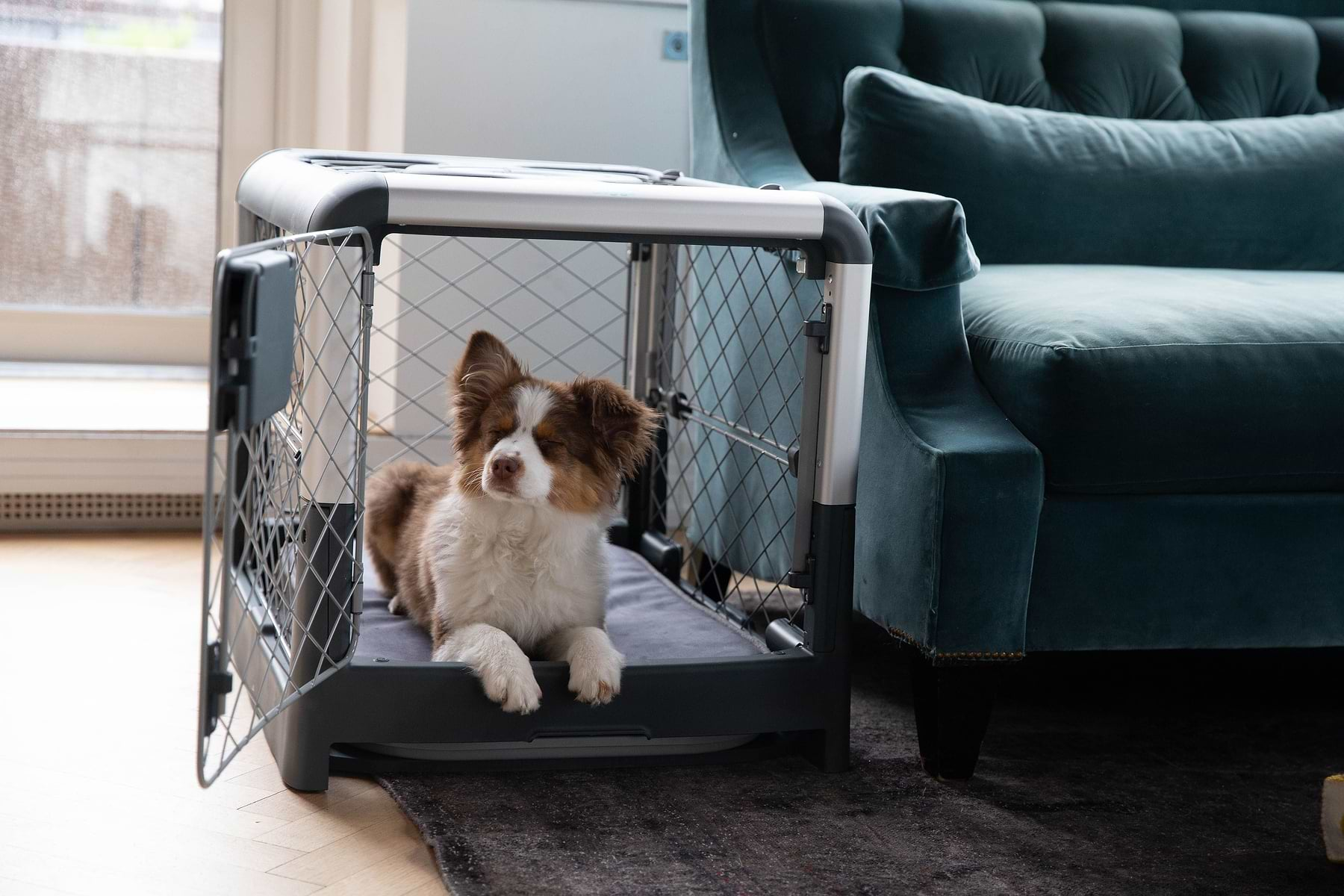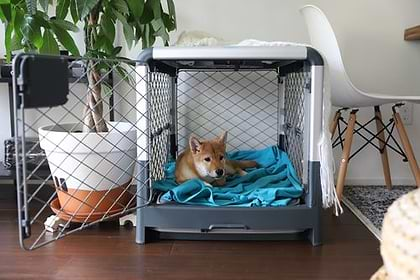Congratulations on the newest addition to your family, your puppy! Ready or not, it’s time to prepare a training schedule to teach your pup the routine around the household.
Crate training is the perfect place to start. Not only does the training avoid accidents around the house and prevent your personal belongings from being chewed or destroyed, but it also teaches your pup that they have a safe, comfortable, quiet den to retreat to when life gets too noisy or overwhelming for them.
Let’s begin with assembling your training plan. Remember that during the training, you want to form a positive relationship between your dog and the crate, not a negative one. The crate should never be used or associated as a place of punishment or confinement for long periods of time for your pup. Instead, let crate time act as a place of comfort and security.
Crates can be versatile and portable, allowing them to travel when you do. Others are stationary, helping to maintain your pets' stress and anxiety levels at ease when you are away. Different people have different opinions, but when crates are used properly, they all serve a positive purpose for you and your pup.
Ready for training? Let’s get started!
Choosing a Crate For Your Dog
It’s time to go shopping. The first step in puppy training is selecting the best crate for your dog. Crates are built with different materials and come in a variety of sizes. So which one is best for your pup?
Crate Size Matters
At this stage, your young puppy is at their smallest size and will grow quickly over time. Of course, their adult size depends on the breed. When selecting the right crate, you do not want one that is too small where your pup’s movements are restricted. Your pup needs enough space to move around and stretch out with ease.
Consider a crate that your pup can grow into, especially if you plan to keep the crate after training is complete. Some crates, like our Revol Dog Crate, come with a puppy divider. This gives you control of its size during training and allows your pup to grow into its environment.
Selecting the Crate Material
Standard crates are made from metal and plastic, but you also can choose from wood and fabric.
Metal crates are flexible and space-saving. They have the ability to fold and take on a lot of wear and tear. This is a great option for your pup, especially during the crate training process. The downside? Metal crates can be an eyesore in the home.
If you want an attractive style, plastic crates are a great option. They are usually sturdy and portable. Plastic crates are not the easiest to move around; however, they can be strong enough against heavy chewers or other destructive behavior.
For purposes of puppy training, fabric and wood crates are not ideal. Fabric crates are hard to clean when accidents occur. It’s best to use fabric carriers with a pup who has already gone through potty house training. Wood crates can make your pup sick if they decide to chew on it. Plus, the material is porous, so accidents are absorbed and quickly create a terrible aroma.
A final option for a crate is a decorative one. These may have a higher price tag, but they can easily be fashioned to match your furniture, adding to the aesthetics of your home, while providing a cozy pen for your pup.
Set-up for Training
After selecting a crate for your pup, it’s time to create the right atmosphere and set-up for training.
Your pup is a student in training but still wants to be involved in your day-to-day activities. When choosing a place to set up the crate, keep it in an area of high traffic. This would be an area where your family spends the most time. This permits your pup to stay engaged in the action around the home, even when it’s time for them to rest in their space for short periods of time.
Have you thought about the marker word, cues, and release words you plan to use with your pup? Common words or phrases include “in” or “out,” including a hand gesture. Or you can use “yes” to indicate your pup did what they were asked. Have these ready before training, and communicate these words to other members of the household so your pup doesn’t get confused depending on whose supervision they are under.
Have treats on standby before diving into training exercises for unwanted behavior. Find one that your pup can’t resist to make the training sessions fun and exciting.
After set-up is complete, it’s time to acquaint your pup with their new home and move on with the training.
Daytime Training: Pup Meets Crate
Introducing your pet to a crate is not to be rushed. Allow your pup to explore on their terms, not yours. This can take a few minutes, or it can take several days before your pup forms a level of trust with the crate. Patience is important.
Encourage your pup to check out the crate and don’t use force. Make the crate inviting to your pup. Add blankets, towels, or use a crate pad for added comfort. Look for a crate pad that is simple to wash when messes occur.
Reward your pup for good behavior. You can use treats to motivate your pup to enter the crate or use their favorite chew toys.
If your pup is still unsure and hesitant to enter the crate, try encouraging them with food. Placing their food and water dish at mealtime within the proximity helps create a positive association between your pup and the crate. Identify a starting point, then slowly move the bowls closer to the crate until your pup has a successful meal experience inside.
As your pup gets more comfortable entering the crate, begin to test the waters by closing the crate door. The first time the door is closed, it may only be for a few seconds. Gradually close the door longer and longer each time your pup is inside. They need to learn that the crate is a safe space for them to sit back and unwind.
Over time, your pup will grow more accustomed to being in the crate and you can be at ease when needing to leave the house.
Crate Training and Puppy Potty Breaks
Puppies are just like newborn babies. They can require attention during the evening hours, especially if they are very young pups. What type of attention? Bathroom breaks. At a young age, their bladder is still growing and developing. This means that they are only able to hold their bladder for a few hours at a time.
Should you plan for potty breaks? Sure—it doesn’t hurt to get your pup on a fixed schedule. Here is an example of what your schedule could look like:
- First thing in the morning, as soon as you wake up. That’s right, don’t stop and browse through your phone messages or email. Your immediate attention should go to your pup.
- Following every meal. Once your pup finishes their meal, wait about 15-30 minutes before taking them outside to take care of business. Keeping them on a set routine eliminates unnecessary accidents from happening in your home.
- After playtime or naps. Anytime your pup takes a snooze, they will need to repeat the “morning routine.” Prepare to take your pup outside after they wake up from a nap.
For more info, read our post on how to crate train your puppy while at work.
Cues To Look For
Accidents can be prevented if you know what to look for. Your pup may be giving you the signals through their behavior. Here are a few cues to look out for:
- Sniffing the floor or a rug
- Wandering off into another room, away from the family
- Whimpering
- Standing by or running over to the door
Training at Night
During the day, you are active with your pup and able to observe their behavior. The setting changes at night. For the most successful results at night, begin training your pup during the day to establish a connection between your pup and the crate.
Keep your pup’s crate close by you at night. You’ll be making frequent runs to the bathroom. Plus, being close to your pup is another way to bond with them. They will feel less lonely knowing you are nearby since you are a part of their pack. At night, you may want to line the crate with puppy training pads too. Best to be prepared for a quick clean-up in case accidents happen!
Let’s assess a few things you can do to make overnights successful with your pup.
Exercise Before Bed
Run, jump, and play with your dog for at least 10-30 minutes prior to bedtime. Exercise both mentally and physically stimulates your pup. They should be ready for rest and relaxation when it’s time for bed.
If walks are not an option for your pup yet because they are not fully vaccinated, there are plenty of other options. How about puzzle toys? Pups love these, especially if food is involved.
Implement a Bedtime Routine
Puppies are creatures of habit. Teaching them a bedtime routine prepares them for what’s next. The routine can be as simple as dimming the lights before bed or playing calming music. You can also find calming oils to soothe your pup’s anxiety or a toy that plays the sound of a heartbeat. Whatever type of routine you choose, repeat it each night before bed so your pup associates it with nighttime, not playtime.
Bedtime Does Not Mean Playtime
When your pup wakes you for a potty break, do not respond in a playful manner. Your pup may get the wrong idea and think it’s time to wake up and frolic. Don’t ignore your pup, rather talk in soft, gentle tones. Keep it boring.
Don’t forget to give your pup praise upon a successful bathroom break outside. Use words of encouragement. Then return your pup to their crate and walk yourself back to bed.
Whining and Barking: What Do You Do?
Remain calm! Whining and barking does not always mean your pup is in pain or in danger, especially while you are potty training.
Your pup may be trying to get your attention so that you’ll let them out of the crate. Consider this as your pup is testing you, observing how you respond to their behavior.
Another reason your pup may showcase this behavior is to communicate with you. Speak to your pup with keywords or phrases you use to associate potty breaks with during training. Watch their response. Are they showing excitement? If yes, try taking your pup outside to relieve themselves.
As long as you have not been reinforcing whining, whimpering, or barking while in the crate with a form of reward, your pup shouldn’t be looking for a handout. This may spark another training exercise to teach your pup that whining doesn’t get your response.
If your pup continues to whine, be mindful of your reaction. Do not lash out at your pup or raise your voice at them. Doing so could make the situation worse.
The Bottom Line
Crate training takes a lot of time and patience. Focus on positive reinforcement with your pup, teaching them that the crate is a safe space. Remember that your puppy is still growing! Keeping them in a crate for longer than three hours is not a good idea as your pup can’t hold their bladder.
Your pup is successfully crate trained once they enter and exit the crate on command, and are able to stay in the crate longer than four hours when you aren’t home.
Crate training is meant to be a positive experience for pets. At Diggs, we know how important it is for your pup to have a comfortable, safe crate to call home. Our Revol Crate is designed ot make crate training easier on you and your pet, with an included puppy divider, multiple points of entry, and a removable tray for easy clean-up.
Best of luck with the crate training process. You’ve got this!
Sources:
What's a Good Crate Training Schedule for a Puppy?
Puppy Potty Training Schedule: A Timeline For Housebreaking Your Puppy

The Diggs Team
We believe our dogs deserve safer, better designed pet products.
You might also like
Crate training tips, stories and inspiration
View all blogsIn Your Diggs
Share your photos with #DiggsPet and tag us @DiggsPet on IG and TikTok.



